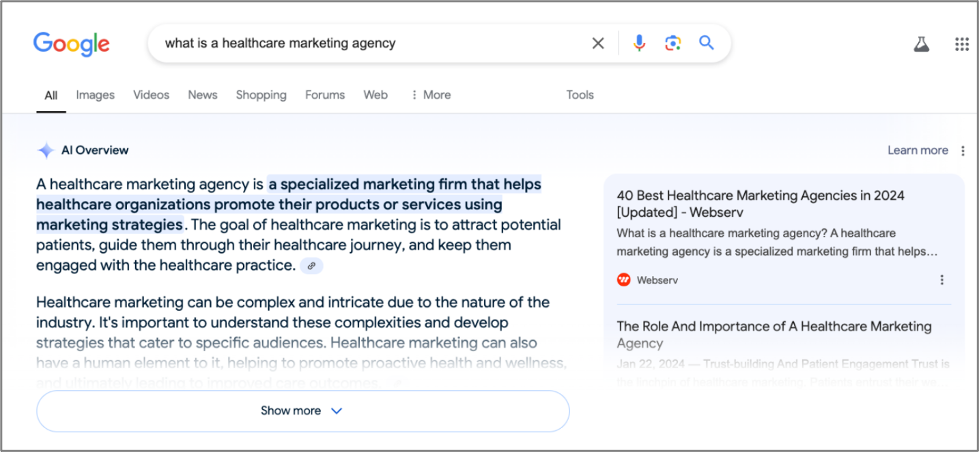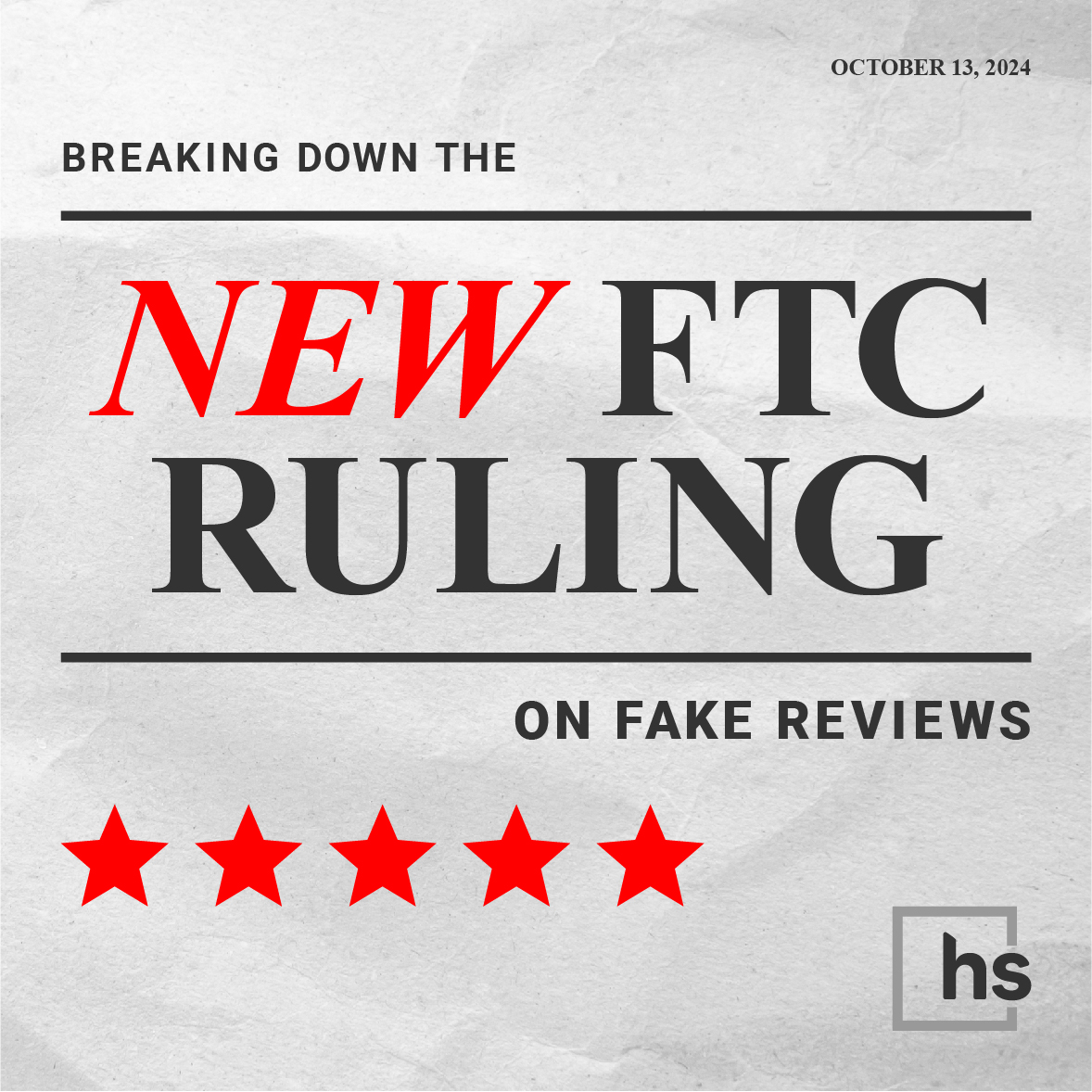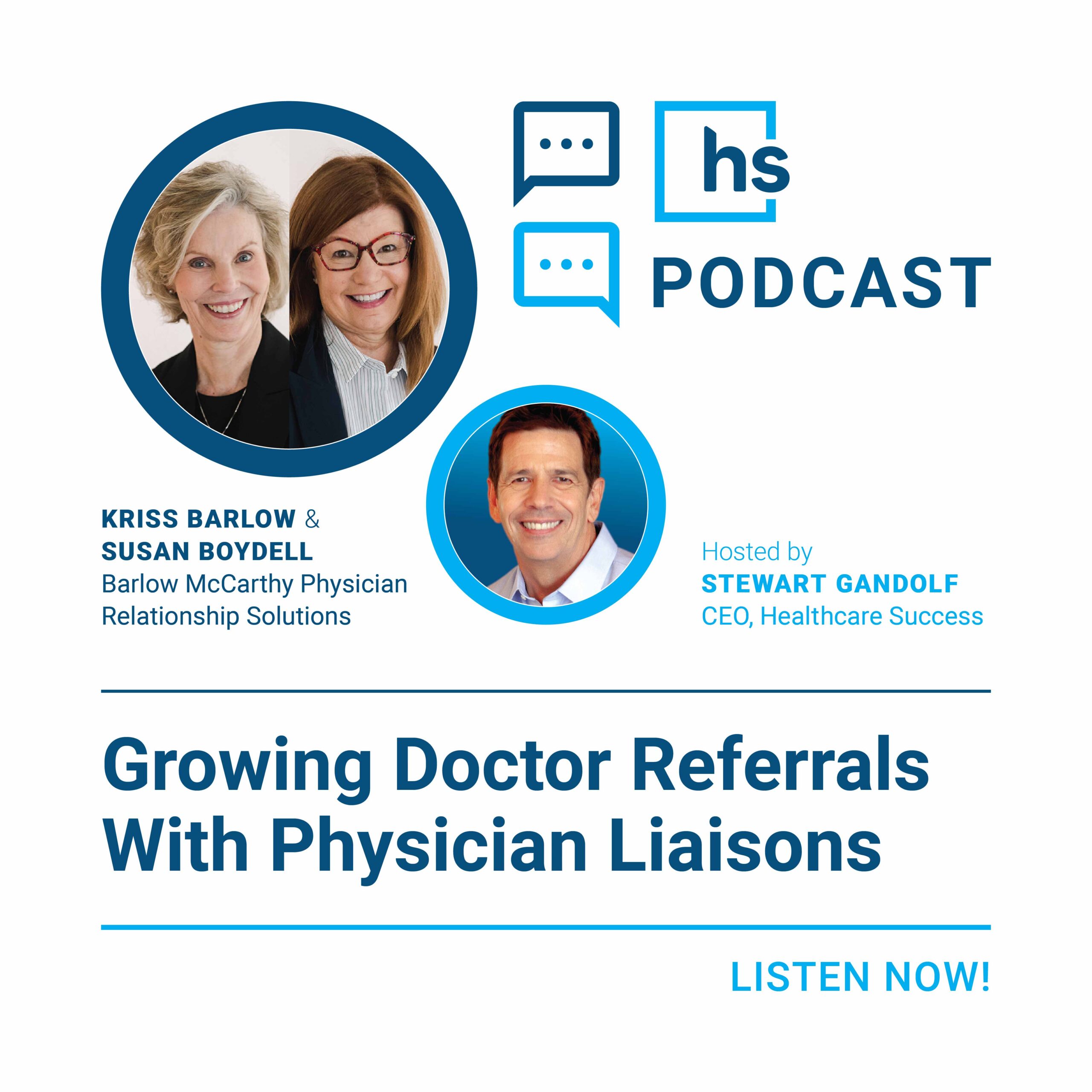Search technology has evolved drastically in recent years.
“Stop talking about keywords, start talking about queries,” I said in a meeting.
What started as simple keyword matching has transformed into a complex, AI-driven system, significantly impacting how we approach digital marketing and SEO.
In this two-part series, I explore the evolution of organic and paid search, discuss its impact on your SEO strategy, and share how your healthcare organization can navigate these changes to enhance online visibility and remain competitive.
First, let’s review the evolution of search and its impact on SEO.
The First Wave: Keyword-Focused Search
Remember when you typed a simple query into Google and got results that matched the exact words you used?
That was the early days of search and is aptly called “exact match.” It relied on basic keyword matching to rank websites, leading to a pandemic of keyword stuffing and link-building SEO tactics that are now considered “black hat” or unethical.
Google’s Panda and Penguin algorithm updates helped suppress and penalize overoptimized pages that used these practices. As businesses acclimated to these changes, an insurance firm, for example, might have had a page for “auto insurance” and another for “car insurance” to ensure they weren’t losing search traffic.
As search technology progressed, advertisers gained the ability to reach a broader audience through more flexible targeting methods:
- Phrase match
This approach is more flexible than exact match, allowing search engines to display paid ads that contain the essence of your keyword, balancing reach and relevance. - Broad match
This match type returns paid results that include phrase match results and their related terms. This is the default match type in Google Ads, helping your ads reach a wider audience without requiring an extensive keyword list. - DSA and Pmax
Dynamic Search Ads (DSA) and Performance Max (Pmax) are advanced match types that prioritize your ads based on how well they match a query. These campaign types leverage machine learning and automation to generate headlines, optimize performance, and allocate budget across several channels.
This evolution reflects a broader trend toward understanding user intent and behavior instead of just keyword matching.
The Rising Tide: Advanced Search Algorithms
With Google’s Hummingbird update, search engines began grasping the meaning and context of queries (not just the individual words) using entities and knowledge graphs.
Entities help resolve ambiguities in search by providing context and knowledge graphs to organize data into factual relationships. These strategies help search engines understand query intent, leading to more accurate and relevant search results.
The word ‘bank’ can have several meanings and functions. I can bank a corner, walk by a riverbank, or take my money to a bank. Entities allow us to see the term, understand which terms are related to it, and the context in which it is being used—eliminating ambiguity and, therefore, irrelevant search results.
Another example is people asking direct questions into search, coinciding with the rise of voice search. One example provided in analyses by our SEO colleagues at the time was, “Who is the richest man in the world?”—which, as a query, is broken down into multiple parts. “Who” expects a person as a result, whereas “richest man” is a property of that person.
One other set of examples includes POTUS, President of the United States, President [Name], and Commander in Chief—all of which refer to the same office and the office holder. Google and Bing would recognize these queries as belonging to the same “entity”—a thing, not a string.
Here’s what we saw as a result:
- Synonym collapse
Instead of just looking for exact keyword matches, entities allow search engines to recognize synonyms and related terms (e.g., car insurance and auto insurance), expanding your content’s reach. - Word2Vec and Word embeddings
These techniques transformed how search engines work by moving past traditional keyword matching methods, like BM25 (Best Matching 25). Instead of just looking at individual words alone, search engines now view them as part of a bigger conversation, almost like a network of connected ideas. This helps search engines understand how words and concepts are related, leading to more relevant and meaningful results.
This shift—from keyword-based to language-based or semantic search—emphasized high-quality content, user experience, and authority, meaning search results are more relevant and aligned with user intent. People were asking questions in a more human way, with more direct questions being asked, even in a chain: “Who is the President of the United States?” followed by “Who is his wife?” followed by “Where did she go to college?” and so on.
The Swell: Mobile Dominance and Voice and Visual Search
As search technology advanced and more users searched on the go, search engines prioritized mobile-friendly websites and adapted to handle more than just typed queries. Here’s what changed:
- Voice search
Entities and semantic search allow search engines to understand spoken language and recognize query types (even when spoken naturally) without requiring exact keywords. This shift makes searching more intuitive and conversational. As a result, people started asking questions like, “Hey Google, what’s the minimum internal temperature for turkey?” - Visual search
Tools like Google Lens allow search engines to analyze and interpret images, identify objects, and provide relevant information about them. Search by image, circle to search, and video search is close at hand.
In a nutshell, voice and visual search fundamentally changed how people interact with search engines. Emerging from this are new ways of querying information regardless of the medium, responding to the uniqueness of the context of the seeker, and demanding a personalized experience.
The Surge: AI and Personalization
AI-generated responses now dominate Google’s search engine results pages (SERPs), and apps like Google Discover make searching a wholly personalized experience.
Google Discover
Google Discover is based less on your queries of ‘now’ but on your prior search history, topics you tend to read, news sources, and general interests. It was almost as if Google was saying, “Here, we found this for you. You didn’t even have to search.” Together, these send a loud and clear call to action to SEO and content strategists— “Stop talking about keywords; start talking about queries.”
Unlike traditional queries, Google Discover curates content based on mobile search history and online behavior, offering businesses a unique opportunity to engage with potential patients before they actively search for products and services.

Google AI Overviews
To stay relevant and visible, you must focus on creating high-quality, helpful content—not content that’s just optimized for search engines.
Your content must be findable, clear, connected, and human to resonate with your target audience.
Google’s new AI-driven overviews lean into this sentiment by prioritizing useful, well-crafted content (though there have been some notable blunders).
Technologies like MuM (Multitask Unified Model), PaLM (Pathways Language Model), and large language models like Gemini (previously Bard) help search engines process and understand different types of information—whether it’s written content, images, audio, or videos—all based on a single query to prompt the information retrieval.

AI overviews can also tailor results by analyzing user behavior, search history, and preferences. This means search engines can now handle more complex, question-based queries than ever before, giving your users access to more accurate, relevant, and helpful search results based on their latest interactions.
What This Means for Your Business
This shift from a keyword-centric approach to a more sophisticated understanding of user intent, context, chain of thought reasoning, and preferences demands new strategies for:
- Search engine optimization (SEO)
You must optimize for semantic search (e.g., context and user intent), voice and visual search. Your SEO strategies must prioritize valuable, relevant, timely, and engaging topic-focused content that aligns with user intent and AI’s ability to understand it. Keywords do still exist, but in a broader context—it is that context we are optimizing toward. - Paid search (PPC)
Your campaigns must adapt to broader match types, focus on ad copy relevance, and use AI-powered tools for optimization. They must focus on precision, efficiency, and automated customization to improve performance and ROI. - Content creation
Your content must focus on user intent, natural language, and visual elements. It must also deliver highly personalized experiences that resonate with target audiences to drive higher engagement. Think of the words in your content as “people” within a social network. What are they attached to, who are they friends with, and what other words or contexts do they engage with?
What’s Next for Search? Trends to Watch in 2025
- More focus on increasing zero-click search
Today, AI overviews often lead to zero-click searches, where users get a relevant answer without ever leaving the SERP. To remain competitive, you must optimize your SEO strategy, focusing on securing placement in featured snippets, knowledge panels, and other SERP features. You can also enhance your chances of being featured using structured data and schema markup on your website. - Follow-up search intent
As machine learning continues to advance, it will better anticipate user needs and generate follow-up queries and answers to keep users on the SERP longer. Focus on getting your products (and services) included in Google’s database to gain more visibility and traction online. - Ranch-style SEO
Begin future-proofing your content strategy now with ranch-style SEO. This method focuses on separating content into precise, digestible, relevant, and high-quality pieces that strategically align with search intent in a human-first way. It’s time to double down on producing the authoritative, high-value content that establishes you as a valuable thought leader in your market.
We hope this overview helps you better understand the evolution of search and its content creation and SEO strategies.
Stay tuned for our October podcast with me, Brandon Schakola, Senior Director of SEO Strategy & Growth at Healthcare Success. In it, we will dive deeper into these changes and how you can navigate them to enhance your online visibility and stay competitive into the future.




